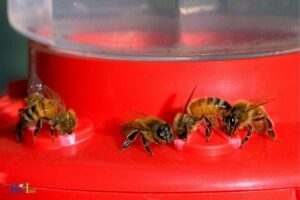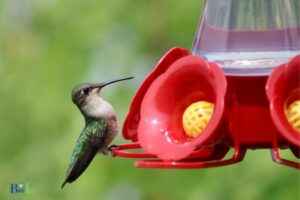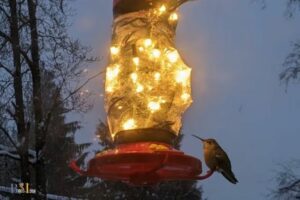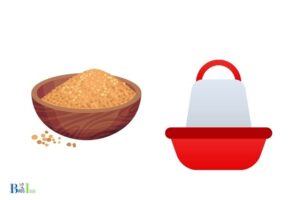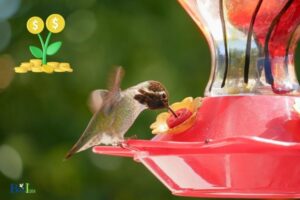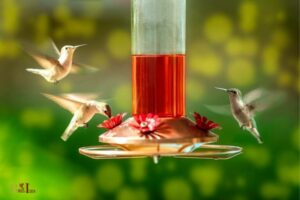Should Hummingbird Feeder Be In Sun Or Shade: 5 Factors!
Hummingbird feeders should ideally be placed in partial shade.
Hummingbird feeders placed in direct sunlight can cause the nectar solution to ferment or spoil quickly especially during the peak summer season.
This is harmful for the birds. Therefore, it is advised to place the feeders in a shaded spot where the temperature stays relatively cool.
If the feeder is in a sunny spot, the nectar solution should be changed every two days to ensure its freshness.
By placing the feeder in partial shade, it ensures that the nectar remains fresh and safe for the hummingbirds to consume without any risk.
This optimal placement will allow the hummingbirds to enjoy the feeder while contributing to their overall wellbeing.
5 Factors About Hummingbird Feeder Be In Sun Or Shade
| Factors | Sun | Shade |
|---|---|---|
| Nectar spoilage | Faster spoilage due to sunlight and heat | Slower spoilage due to cooler temperatures |
| Hummingbird visibility | Easier for hummingbirds to spot | May be harder to spot in darker areas |
| Bird comfort | May cause overheating in extreme heat | Cooler and more comfortable for birds |
| Plant growth | Attracts birds with growing flowers | Less plant growth and fewer flowers |
| Predators | Easier for predators to spot hummingbirds | More protection from predators |
Key Takeaway
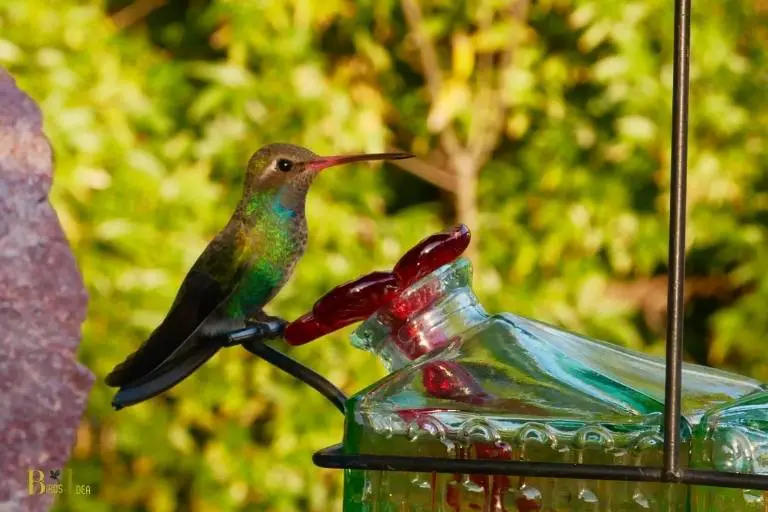
Five Facts About: Placement of Hummingbird Feeders in Sun or Shade
Pros and Cons of Putting a Hummingbird Feeder in the Sun
Placing a hummingbird feeder in the sun can have both positive and negative effects. It’s important to weigh these pros and cons before deciding on the best location for your feeder.
Pros:
- Sunlight can attract hummingbirds due to the bright colors of the feeder and the nectar within.
- Sunlit feeders are generally easier for hummingbirds to spot and access.
- Warmer temperatures can prevent nectar from freezing during colder months, ensuring that hummingbirds have a consistent food source.
Cons:
- Direct sunlight can cause nectar to spoil more quickly, requiring more frequent cleaning and refilling.
- Excessive heat from the sun may lead to nectar evaporation, reducing the amount of food available to hummingbirds.
- A feeder in direct sunlight can become too hot, potentially causing discomfort or harm to hummingbirds.
To ensure the best possible environment for hummingbirds, consider the following tips:
- Monitor the feeder for spoilage, and clean and refill it regularly to maintain a fresh food source.
- Keep an eye on the temperature of the nectar and move the feeder to a shadier location if it becomes too warm.
- Provide multiple feeders in various locations, including both sunny and shaded areas, to make sure all hummingbirds have access to a comfortable food source.
“It’s important to monitor the feeder and check for any signs of spoilage or contamination.”
BIRDSIDEA
Benefits of Placing a Hummingbird Feeder in the Shade
Placing a hummingbird feeder in the shade rather than in direct sunlight offers several advantages for both the hummingbirds and the feeder’s maintenance.
Shade provides a more comfortable and safer environment for the birds to feed, while also prolonging the freshness of the nectar and reducing the need for frequent cleaning.
By choosing a shaded location, you can attract more hummingbirds, promote their well-being, and better enjoy watching these fascinating creatures.
- Comfortable feeding environment: The shade helps keep the nectar cool, making it more refreshing for the birds on hot days.
- Better nectar quality: Prolonged exposure to sunlight can cause nectar to ferment or spoil, making it less appealing for the hummingbirds.
- Reduced algae and mold growth: A cooler, shaded area slows down the growth of algae and mold in the feeder, requiring less frequent cleanings.
- Enhanced safety: Placing the feeder in the shade can provide some protection for hummingbirds from predators like cats or larger birds.
- More visitors: Hummingbirds may be more attracted to a feeder in a shady location, as they often rest in shaded areas between feeding sessions.
To ensure the best experience for the hummingbirds and for your viewing pleasure, make sure the feeder is still visible from a window or favorite viewing spot, even when placed in the shade.
Tips for Choosing the Perfect Shade for a Hummingbird Feeder
Choosing the perfect shade for a hummingbird feeder is an essential aspect of attracting these fascinating creatures to your backyard.
The color of the feeder plays a crucial role in grabbing the attention of the hummingbirds and making them feel comfortable enough to approach and feed.
To ensure maximum attraction, consider the following key factors while selecting the ideal color for your hummingbird feeder:
- Bright colors: Hummingbirds are attracted to bright colors, particularly red, as it is the most visible and eye-catching for them. However, other bright shades like orange, pink, and yellow can also be effective.
- Contrasting colors: Combining different contrasting colors can also help in capturing the attention of hummingbirds.
- Avoid mirrored or metallic colors: These can be confusing or intimidating to hummingbirds, making them less likely to visit your feeder.
Effects of Sunlight on a Hummingbird Feeder
Sunlight has both positive and negative effects on a hummingbird feeder. Placing a hummingbird feeder in a sunny area can attract more hummingbirds as they are drawn towards bright colors and sunlight.
However, excessive sunlight exposure can cause the nectar to spoil quickly and promote bacterial growth, which is harmful to the birds.
Additionally, sunlight can cause your feeder to degrade over time, particularly if it’s made of plastic.
Therefore, it is essential to strike a balance between providing enough light to attract hummingbirds and protecting the feeder from the adverse effects of sunlight exposure.
Positive effects of sunlight on a hummingbird feeder:
- Attracts more hummingbirds
- Enhances the visibility of the feeder
Negative effects of sunlight on a hummingbird feeder:
- Spoils nectar quickly
- Promotes bacterial growth
- Degrades feeder material
Should hummingbird feeders be in sun or shade?
To attract more hummingbirds, consider planting native flowers that produce nectar alongside the feeder. This not only provides an additional food source but also adds a visually appealing element to your garden.
BIRDSIDEA
Does sugar water go bad in the sun?
Hummingbird feeders should ideally be placed in a shaded area to prevent the sugar water from spoiling due to exposure to the sun.
Sugar water can go bad in the sun, as the heat and sunlight can cause fermentation which can be harmful to hummingbirds.
It is recommended to place the feeder in an area that receives partial sun or shade for at least a part of the day.
Additionally, it is important to clean the feeder regularly and replace the sugar water every few days to prevent the growth of harmful bacteria.
Here are some tips to keep in mind when placing your hummingbird feeder:
- Place the feeder in a shaded area to prevent the sugar water from spoiling due to exposure to the sun.
- Choose an area that receives partial sun or shade for at least a part of the day.
- Clean the feeder regularly and replace the sugar water every few days.
- Be mindful of the location of the feeder and try to keep it away from areas with high foot traffic or potential predators.
Where is the best place to put a hummingbird house?
Where is the best place to put a hummingbird house or feeder is a common question among bird enthusiasts.
The ideal location for a hummingbird house or feeder should be in an area that is easily visible and accessible to the birds.
Besides, the location should be able to provide the birds with enough natural shelter and protection from predators.
When it comes to the issue of positioning the feeder, it’s essential to consider the weather conditions and the type of feeder being used.
It is recommended that the hummingbird feeder should be placed in a partially shaded area, particularly during the hottest part of the day, to keep the nectar fresh.
Here are some of the best spots to place a hummingbird house or feeder:
- Hang it in a garden where hummingbirds frequent
- Near a window where you can easily see the birds
- Under the branches of a tree or a shaded area to protect the nectar from the direct sunlight
- Away from other bird feeders to avoid conflicting bird interactions.
What color is best for hummingbird feeder?
Hummingbirds are attracted to vibrant colors, especially shades of red and pink. Therefore, it is best to choose a hummingbird feeder that is brightly colored.
However, it is important to note that the color of the feeder is not the only factor that attracts hummingbirds.
The location of the feeder also plays a crucial role. Hummingbird feeders should be placed in areas that have easy access to shade and sunlight.
Placing the feeder in the shade will help to keep the nectar cool and fresh, while also providing a comfortable environment for the hummingbirds.
On the other hand, placing the feeder in direct sunlight will help to keep the nectar warm, especially during cooler weather, making it easier for hummingbirds to feed.
Therefore, it is best to choose a location that provides a balance of both shade and sunlight.
Some additional tips to keep in mind when choosing a hummingbird feeder color and location are:
- Choose a feeder with colorful flowers or decorations to further attract hummingbirds
- Place the feeder near natural sources of food, such as flowers and trees
- Clean the feeder regularly to prevent mold and bacteria buildup.
Which hummingbird feeder is best?
When it comes to choosing the best hummingbird feeder, one of the important considerations is whether it should be placed in the sun or shade.
While it may seem logical to place it in the sun to keep the nectar warm and attract more birds, excessive heat can cause the nectar to spoil quickly and potentially harm the hummingbirds.
On the other hand, placing the feeder in the shade can help keep the nectar fresh for a longer time, but it may not be as visible to the birds.
Therefore, the best option is to find a spot that provides a balance of both sun and shade.
Here are some additional tips to help you choose the best hummingbird feeder:
- Look for feeders with bee guards to keep bees away from the nectar.
- Choose a feeder with multiple ports to accommodate more birds.
- Opt for feeders with easy-to-clean designs to prevent mold and bacterial growth.
- Consider hanging the feeder from a tree branch or using a feeder pole for stability.
In conclusion, finding the right location for your hummingbird feeder and selecting a feeder with features that meet your needs can enhance the experience of attracting these beautiful and fascinating birds to your backyard.
What Colour is best for bird feeder?
When it comes to choosing the best colour for a bird feeder, it’s important to consider the type of birds you want to attract.
For hummingbirds, it’s recommended to use feeders that are coloured red, as this attracts them the most.
As for the placement of the feeder, it’s suggested to keep it in partial shade, as this will keep the nectar cool and fresh for a longer time.
Direct sunlight can cause the nectar to spoil, which can be harmful to hummingbirds. Additionally, placing the feeder near flowers or other sources of nectar can also help attract these fascinating birds to your yard.
To summarize, the best colour for a hummingbird feeder is red and it should be placed in partial shade to keep the nectar fresh.
Here are some additional tips:
- Keep the feeder clean and full of fresh nectar
- Avoid using food coloring in the nectar
- Place the feeder near flowers or other sources of nectar
- Avoid placing the feeder near windows or doors where birds might accidentally fly into them
- Enjoy the beauty of these amazing birds as they visit your garden!
What is a calming color for birds?
If you’re trying to attract birds to your yard, the color of your hummingbird feeder can make a difference.
Brightly colored feeders can be attractive to hummingbirds, but may also attract unwanted attention from other birds or insects.
Calming colors like red, pink, and purple can be effective in attracting hummingbirds while discouraging other animals.
It’s also important to consider the location of your feeder. Hummingbird feeders should be placed in a shaded area to keep the nectar from spoiling too quickly.
Direct sunlight can also cause the nectar to ferment, which can be harmful to hummingbirds.
Here are some tips for hanging your hummingbird feeder:
- Hang the feeder in a shaded area, away from direct sunlight
- Place the feeder in a location where it can be easily accessed for cleaning and refilling
- Keep the feeder away from windows to prevent collisions
- Use a hook or other secure hanging device to prevent the feeder from falling or swinging in the wind.
By following these tips, you can create a safe and inviting environment for hummingbirds in your yard.
FAQ for Should Hummingbird Feeder Be In Sun Or Shade
Should a Hummingbird Feeder Be Placed in Sun or Shade?
Additionally, providing some shade will also help keep the birds away from predators such as cats, hawks, and squirrels.
Should I put my hummingbird feeder in sun or shade?
What are the benefits of having my hummingbird feeder in the shade?
How often should I change the nectar inside the feeder?
Conclusion
In conclusion, there are pros and cons to placing a hummingbird feeder in the sun or shade. While sunlight can help keep the nectar fresh and deter insects, it can also cause the nectar to spoil quickly and overheat the feeder.
On the other hand, shade can prevent spoilage and overheating, but may attract more insects.
To find the perfect location for your hummingbird feeder, consider the climate, amount of shade available, and the type of feeder you have.
Ultimately, the most important factor is to keep the feeder clean and fill it with fresh nectar regularly. By taking these simple steps, you can enjoy the beauty of hummingbirds in your garden all season long.

